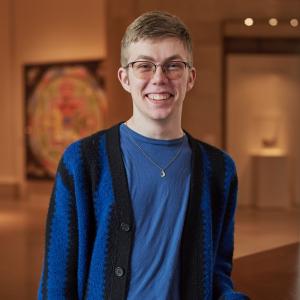Witnessing Fall Forward
November 20, 2023
Ozzie Frazier '27
 “DEAR AUDIENCE” reads the folded slip of paper I have just been handed. Around me, the sound of ripping paper fills the vaulted ceilings of Warner Main as audience members open the pamphlets they have received. This was the opening to the fourth number of Oberlin Dance’s Fall Forward, a recital of student-choreographed pieces with artistic direction from Alysia Ramos that I watched on its (sold out!) closing night, November 4th. Despite varied emotional themes, each of these pieces touched me in a unique way. Throughout the evening, I felt confronted by the message of the bold handwriting in front of me: What is a performance without the audience?
“DEAR AUDIENCE” reads the folded slip of paper I have just been handed. Around me, the sound of ripping paper fills the vaulted ceilings of Warner Main as audience members open the pamphlets they have received. This was the opening to the fourth number of Oberlin Dance’s Fall Forward, a recital of student-choreographed pieces with artistic direction from Alysia Ramos that I watched on its (sold out!) closing night, November 4th. Despite varied emotional themes, each of these pieces touched me in a unique way. Throughout the evening, I felt confronted by the message of the bold handwriting in front of me: What is a performance without the audience?
Although “perform” can be defined in two different ways (“to carry out” or “to present to an audience”) I think the combination of the two is what makes a dance piece complete. Yes, the dancers carry out the actions of the choreography, but they cannot truly perform if no one is watching.
Date Me, although the last piece of the show, is the first of three that I'd like to focus on. Choreographed by Kendall, this number features dancers in a variety of colorful outfits, including Kendall herself. With a catchy repeating chorus and MUNA vibrating through our seats, it felt as though the entire audience was dancing along. In fact, several audience members were so enthusiastic about this performance that they shouted words of encouragement best left unrepeated. Intended to celebrate “queerness and femininity,” performers' unique costumes represent “freedom of style” in contrast to the conformity of synchronized choreography. My favorite moment of this piece—amongst many great ones I might add—is when all of the dancers explode from their orderly formation into an open circle. Facing each other, they all jump and land in perfect synchronicity with the music, and my skin ripples with goosebumps. There’s something incredibly satisfying about watching a group of people deciding to move exactly the same way at exactly the same time, and I appreciated Kendall’s commentary on this synchronicity as a way to embrace each dancer’s unique identity.
As I consider this number in relation to the definition of performance, I'm curious as to how this piece would be different with a less enthusiastic audience, or one that was less queer. At Oberlin, our community prides itself on fostering safe spaces for diverse expression, but that's not the case everywhere. Would this piece mean something else if it were performed in front of exclusively straight people? While there were no explicit acts of queerness within the piece, I imagine that the performers might have had an air of defiance rather than pride and celebration if they had to dance in front of a less supportive audience. This question asks us to consider how performances are impacted by the specific people watching them.

Photo credit: Lucho Rubio Fernandez
Speaking of special performances, I'd also like to highlight Patient 6183, a senior capstone choreographed by Liz. Incorporating not only dance but also theater, this twenty-minute piece explores the limitations of navigating the world in a disabled body. Throughout the piece, the six dancers represent different aspects of Liz’s personality, occasionally portraying doctors or nurses who speak directly to the audience. Telling the story of Liz’s scoliosis and fibromyalgia, these six performers chart themes of “self acceptance and self worth,” as well as the challenges of being viewed as a case number more than a person. As the performers float across the stage in spontaneous bursts of energy, there's a tangible release of the built-up tension created by the serious dialogue. The audience takes a deep breath, sheds a tear. One thing I found especially moving about this piece was the story of “dancing the way our bodies need us to” as a way to navigate pain and move through the world in more embodied way. In Patient 6183, dancing Contact Improvisation was one of the main ways Liz started to feel at home in their body.
In the discussion of audience relationships, this struck me as quite powerful. Contact Improv is a form of dance that often does not have an audience, and in fact relies deeply on awareness within oneself rather than of the people watching. There are many forms of dance that are not required to be performed, and yet each of the choreographers in this show chose to create a performance and share it with me, one of hundreds of viewers over the course of the weekend.
Another piece that was greatly impacted by audience engagement was Autumn Feverrr, a street-style solo choreographed and performed by Kim. I first met Kim when our dance classes combined earlier in the semester. Even in a room full of fifty people, her fiery enthusiasm was wildly contagious on that day. Although we haven’t interacted personally, I can tell that Kim’s vibrant energy directly translates into her dance. Her performance in Fall Forward incorporates a mix of both “choreography and improvisation,” and I’m shocked by how rapidly the energy in the room shifts when she comes on stage. As she stomps into the room, the room fills with raucous applause, anxiously awaiting the first notes of Fiebre by Bad Gyal. Accentuated by a bold rectangle of light, her passionate performance is met with continuous whooping and hollering from the audience. Yet again I ask myself, what would this piece be without the audience? On stage, it seems as though the audience’s cheers become a part of Kim’s soundtrack, feeding into her energy and vice versa. In an empty practice room, I imagine that this piece would not take on the same brilliant mood.
As a performer myself, I can attest to the fact that performing to an empty room just doesn’t have quite the same energy. In fact, it can sometimes be draining to turn on a smile and pull out all the stops when no one's watching. This means that performance itself is a type of exchange: by becoming an audience member and witnessing Fall Forward, I provided energy to the performers. In return, they provided me with excitement, laughter, chills, and even tears. There's something magical about this audience-performer relationship that can never be exactly replicated. Every audience is a little bit different, but that’s what makes each performance special. No matter what each dancer and audience member has been doing until that point in their life, a performance requires us all to stop and be together, largely uninterrupted.
I leave Fall Forward without knowing every dancer’s name and story, but I feel more connected, inspired, motivated. Something within me has changed: I have borne witness to a great thing that will never happen again. I can’t say exactly what goes on in the dancers’ minds during all this, but I would hope it is a similarly moving experience for each of them. So, as I prepare myself to go back to the real world after being present for this performance, I'm grateful for the rawness that these dancers have shared with me. I feel incredibly fortunate to have contributed to this performance, even if only as a witness.
Similar Blog Entries


My Obligatory Eclipse Blog Post
April 28, 2024
